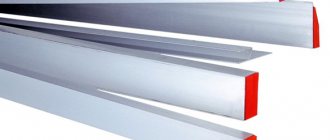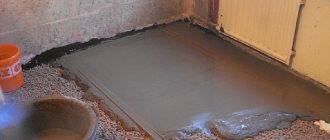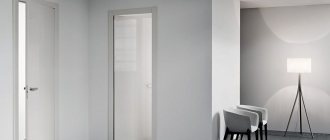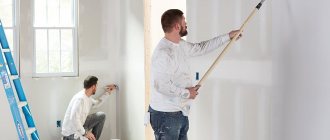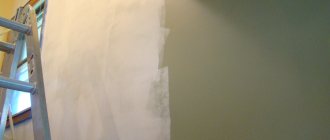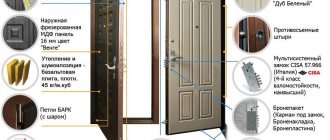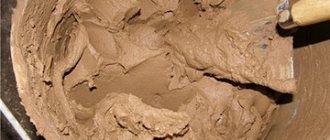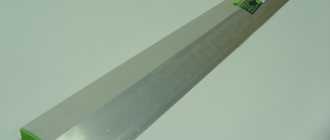The building rule is a tool for construction work, most applicable to plastering work. Without it, making a flat wall becomes much more difficult. It is easy to use, and the results are not much different from those obtained by professionals. How to choose a rule, photos with illustrations, nuances of use - further in the article.
Characteristic features of the rule
What is a building code? The first models of the instrument were made of dense wood. The disadvantage of this design was considered to be its good hygroscopicity.
Excessive absorption of moisture led to destruction of the wood and rapid deformation of the product.
Later they began to make it without aluminum. Why did you choose this particular material? This choice is based on several factors:
- Aluminum alloy is not subject to corrosion. The design can last a long time without damage;
- Another advantage of aluminum is its weight. Unlike other metals, it is slightly lighter. As a result, working with such a tool is easier and more convenient. The minimum weight of the structure allows the building composition to be evenly distributed on the plane.
An important characteristic of this product is the level of rigidity of the metal base. The thickness of the metal walls, which provide strength, depends on the length.
The best manufacturers
A good tool is made by the best manufacturers. Let's get to know some of them.
Matrix
Trademark of the German company Matrize Handels GmbH. Its product range includes at least 3,000 models. Among them are tools used in construction and repair:
- locksmith;
- carpentry;
- measuring;
- car repair kits;
- cutting tools for various purposes and designs;
- various fasteners.
As for the company’s construction finishing products, professionals pay tribute to its brushes, rollers, brushes, spatulas, trowels, trowels and, of course, rules of various profiles. Popular models of trapezoidal two-pieces are in high demand among experts.
JET
The American tool company JET Equipment & Tools was founded in 1958 in Seattle. The company became famous for its wood/metalworking equipment and even took a leading position in the United States in this market. Hand tools are not her main focus. Nevertheless, the popularity of JET models among professionals is high, and their quality matches the manufacturer’s reputation.
FIT
A trademark of the Canadian company of the same name, Finch Industrial Tools Canada Inc. The main direction of its activity is the production of hand-held power tools. We also produce hand tools for finishing work, including construction rules of various profiles and sizes. FIT is a quality product at a reasonable cost.
Bartex
Manufacturer from China. It has been on the market for quite a long time and has managed to gain popularity among buyers. The assortment includes many items for plumbing, carpentry and finishing purposes. All products are manufactured by large Chinese companies. The quality is at the level of world standards, the prices are budget.
Kraton
One of the domestic manufacturers of equipment and various equipment. For 18 years, the company has been pleasing its consumers with high-quality products and a wide range. Its abrasive wheels, compressor units, etc. are especially valued by professionals. The construction range includes everything needed for professionals, including spatulas, trowels and rules. All products are of high quality.
Bison
Russian manufacturer of professional tools. On the market since 2002. Today it is one of the leading domestic companies in this business. Zubr products are in demand among professionals and do-it-yourselfers. All products undergo serious quality control and meet the requirements of GOST and international standards. All models are issued with a warranty card valid for five years.
Biber
Manufacturer from Germany. Formed in 1950. The buyer knows this brand for its cleaning and care products for textiles, and products for making household work easier, including for apartment renovation. The European consumer appreciated the quality of its spatulas, rollers, brushes, paint containers and building regulations. Production facilities are located in Europe and China.
Stayer
The owner of the trademark is the German manufacturer – Kraftool. Our compatriots became acquainted with its products in 1999. The instrument with the Stayer brand was distinguished by its high quality and stylish design. Product production is deployed on modern equipment of factories in Germany and the Czech Republic, China, Taiwan and Malaysia. The manufacturer has developed four main lines of tools:
- for domestic use, models marked Standard are produced;
- home craftsmen are intended for products marked Master on the body;
- professional instruments are sold marked Profi;
- universal models, marked Universal.
The company annually develops new models, uses modern technologies, materials and innovations.
Our tool
The brand belongs to the Russian company Santool. The tool is created using a unique production technology, using components from the world's best manufacturers. Inexpensive products of this brand can be found at many construction sites in Russia and the CIS countries.
Armero
A new company on the tool market has Spanish roots. Buyers like models from Armero for their modern materials, ergonomics, and bright colors.
Interesting! "Armero" is translated from Spanish as "Armorer". Once upon a time, a company produced weapons.
Today, its specialists recreate and support the traditions of Spanish gunsmiths, creating high-quality instruments, the possession of which requires skill and gives aesthetic pleasure.
The market is saturated with quality tools. The number of excellent manufacturers cannot be counted. In order not to make mistakes when choosing a suitable model, you should carefully study the descriptions and characteristics of several products, listen to the advice and recommendations of experienced craftsmen, and consult a seller in a specialized store. By collecting as much information as possible about the product, it will be easier to decide which company is better to buy the product.
What are building rules used for?
The construction rule must be applied during construction and repair work. This design is considered an indispensable type of tool that is used to level mortar on the surface of the wall and floor.
It is chosen for working with pouring the floor with concrete or dry screed. When used correctly, it is possible to obtain a flat surface for further decoration.
The metal product is used to perform the following manipulations:
- Marking. The long base ensures a straight line. Most often, the products are used for marking before installing ceramic tiles or creating layouts;
- Additional support when cutting glass. Metal strips reduce the load on the fragile base and prevent its destruction;
- Fastening beacons before starting plastering;
- Use as a level. Thanks to this product, it is possible to prevent the appearance of unevenness and differences on the surface of the wall and floor.
This type of construction tool is considered indispensable during repairs and surface leveling. Different lengths and widths of the metal base allow it to be used in rooms of different sizes.
The most common construction model is considered to be a device whose length reaches from 1.5 to 2.5 m. The maximum dimensions of a tool are considered to be 3 m in length.
An ordinary wooden lath or a long building level can level the liquid mortar. It is much easier to work with such a device. The point is that when working with the rule, it is important to have dexterity. The design of the product has an acute angle, which is designed to remove excess volume of the building composition.
The minimum weight of the product ensures comfortable work over a long period of time
Leveling using the plaster layer rule.
Leveling the plaster is done by cutting off excess mortar using a rule sliding along pre-installed support slats - beacons.
They are leveled and represent slats located in an ideal plane. If they are present and properly installed, it is almost impossible to plaster unevenly.
Plastering is usually the most affordable way to finish walls.
Types of building regulations
The rule considers it one of the components when carrying out plastering work. To obtain an ideal plane, you will need to use several models of the device. Thanks to the different lengths and widths of the metal base, the working composition evenly fills voids and unevenness on the concrete base.
In turn, building rules are divided into several categories. Each type has a different shape and size.
These include:
- H-shaped models;
- Trapezoidal designs;
- Corner products;
- Rectangular;
- With metal teeth;
- Combined types.
Let's look at the advantages and disadvantages of each type.
How to choose a rule
When choosing a tool with an h-shaped profile, you should pay attention to the absence of shells and foreign inclusions in the metal, and to the color of the aluminum - a yellowish tint indicates the low quality of the material.
For a trapezoidal rule, it is highly desirable to have a notch in the form of a semicircular groove along the entire length of the instrument on the back surface, for ease of holding it in your hands.
The highest quality tool, in addition to this notch, has stiffening ribs inside the rule. Nothing will happen to it if you accidentally drop it from a height, step on it, or drop a hammer on it.
When choosing a rectangular rule, the same principles apply as for the first two types.
Features of the h-shape rule
This type of building rule is considered the simplest. In addition, products of this type are characterized by minimal weight. To achieve this effect, a thin-sheet aluminum alloy with a minimum number of ribs was used to provide additional rigidity.
Low weight is considered an advantage, but at the same time a disadvantage. The positive qualities of such a tool are considered to be convenience when performing installation work, and the disadvantages are the limited capabilities of the model.
The special design makes the tool easier to use. The metal protrusion is used as a handle. It is chosen for plastering the plane of walls. To perform a concrete floor screed, you should not choose such a product.
Where can I buy
The easiest option is to visit a hardware store. Today, in any city there is sure to be a specialized retail outlet and more than one. In such stores you can look at, touch, thoroughly evaluate the product and choose what you need. It is advisable to visit the manufacturers' websites. All the information necessary for the buyer is published on their pages:
- news about what new products the manufacturer has released for sale this year;
- description and technical parameters of all models in production;
- price data for any model;
- addresses of stores where you can buy the company's products.
It happens that there is no time or desire to go shopping. Then you will have to use the second option - order goods online from an online store. Today this is done very simply. True, the buyer must be confident in the chosen store, otherwise problems may arise with delivery or quality of the goods.
Advantages of the trapezoidal rule
Rules in the form of a trapezoid are distinguished by their rigidity. This model is considered the most popular and in demand. You can choose it for interior and exterior work. Most often, the trapezoidal rule is used for working with heavy types of mortar.
The presence of an acute angle ensures unimpeded removal of excess layers of concrete. The disadvantage of such products is their high cost. The internal part of the structure is lightweight, thereby reducing the weight of the device.
- The required rigidity can be achieved due to the geometric shape of the product.
- The back of the tool is used as a handle.
- Thanks to her, it is possible to achieve a good emphasis.
- A distinctive feature of the trapezoidal model is the presence of several gutters, which are located on all sides.
Description of the tool
The term plastering rule itself means a tool that is used to correct defects and correct layers. But professionals use it for more diverse purposes. The tool may differ in size, as well as in the materials used in its production.
The term plastering rule itself means a tool that is used to correct defects and correct layers.
Rectangular Shape Rule
To carry out installation work, professional craftsmen prefer to use several forms of metal strips. Some models have a large flask with liquid.
It allows you to control the level of inclination on the plane.
- A distinctive feature of the rectangular building rule is considered to be high rigidity.
- They prefer to choose such products for decorating a concrete floor screed or evenly distributing a thick mortar on a vertical surface.
- For novice craftsmen, this form of tool will seem inconvenient.
- The fact is that wide ribs make it difficult to control the level of inclination on the surface.
- An acute angle is unable to remove a large volume of excess building composition.
When using the rectangular rule with a capsule, it is important to consider that in order to correctly determine the angle, it is necessary to adjust the structure.
During the operation of the product, violations of the indicators are observed. With the correct positioning of the tool, it is possible to achieve a level base.
Reviews
Plasterers and painters have a pretty good opinion about h-shaped rules. Judging by the reviews, working with this tool is actually more convenient than using a standard wooden one. Experts include the following advantages of tools of this type:
- high degree of rigidity;
- wide working part;
- durability.
Rules of this type do not bend during redistribution work. As the craftsmen note, due to the high rigidity of the material used for the manufacture of such tools, h-shaped devices usually remain smooth even after many uses.
For work, h-shaped rules, as the masters point out, are more than convenient. Professionals also point out that the significant advantages of leveling devices of this type are that a lot of mortar can be placed on their shelf when grouting. In this case, it is convenient to remove the solution from the sole and apply it back to the wall, filling the remaining voids. The same trapezoidal instrument will not be able to perform such a procedure.
When working, the rule of this variety simply hangs on your fingers. As a result, the master is able to freely adjust the “grip” angle. If desired, it can be made almost zero and run parallel to the wall.
When cleaning, the solution from the working sole of such a tool is removed with a regular spatula in one movement. The configuration of trapezoidal rules is less convenient in this regard.
Photo of building regulations for plaster
Angular rule
There is also an angle plastering rule, which is a tool for determining the exact angle for external and internal plastering. This tool is indispensable for finishing walls based on cement or gypsum. The device can be used for manual or mechanized application of the mixture. Plastering stations will also help with the work.
Many organizations are involved in the production of plaster rules. Among others, SLOWIK should be highlighted. For a corner model you will have to pay 2,500 rubles. The company is located in Poland and produces many types of wall leveling tools. This includes, for example, H-rules, trapezoidal devices, as well as universal rules, which are a combination of trapezoid and H-model.
Work without beacons
In most cases, plastering using this technology is carried out when there is no need to slightly level the surface without serious defects. The prepared solution is applied to the wall and stretched with a spatula. After this, it is necessary to distribute the solution along the wall without moving from side to side. You need to move from bottom to top.
Using the tool, you can remove excess material that accumulates on the wall, as in the previous technology. Once the first layer of material has dried, the rule can be applied to different parts of the wall at different angles. If no gaps have formed between the tool and the wall, everything went well. Otherwise, you can apply another layer of plaster. At the final stage, you can begin processing corners and hard-to-reach areas. The procedure looks the same as in the case of working on beacons. After all the manipulations, the evenness of the wall can be checked again.
